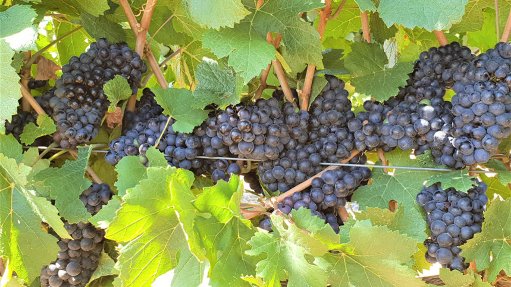
The 2018 harvest amounted to just over 1.2-million tonnes, 14% smaller than the previous year, mainly owing to the drought
The 2019 South African wine grape harvest is expected to be only slightly larger than that of 2018, as vineyards are still recovering from a three-year drought, bad weather during fruit set in October and a continued decline in wine grape vineyards, agricultural association Vinpro said in a statement on Monday.
This announcement follows the release of the second wine grape harvest forecast by viticulturists and producer cellars, issued by the wine industry body SA Wine Industry Information & Systems (SAWIS) this month.
The 2018 harvest amounted to just over 1.2-million tonnes, 14% smaller than the previous year, mainly owing to the drought.
“The main reasons for the smaller crop in 2019 are the poor set of wine grape bunches that are being observed throughout the Western Cape [as a result of] wet, cold conditions and wind experienced in October last year,” Vinpro consultation services manager Francois Viljoen said.
He added that vineyards also do not grow with similar vigour throughout the regions, which is also the result of the severe drought experienced last season.
The quality of this year’s vintage will depend on the weather over the next few weeks, which Vinpro believes looks promising at this stage with cooler conditions.
Average to lower yields are expected, but grapes are generally healthy owing to looser bunches that lower the risk of rot setting in. Sufficient water resources will be available in most regions, the association added.
With the summer season moderate at this stage, and sufficient water supplies available in most regions for irrigation during the ripening period, the eastern part of the Klein Karoo still suffers from a severe drought.
“The 2017/18 season forever changed our frame of reference about our water resources and way of thinking about water in general and we had to come up with new ways to accumulate and save water and use this scarce resource more efficiently,” Viljoen reminisced, adding that, in some cases, vineyards had to be managed with 50% less water than usual and in some extreme cases with only 16% of the normal water allocation.
Some vineyards, as a result of the drought, “took a beating” and will take time to recover.
The chances of the drought having a carry-over effect in areas like the Olifants River region and the Coastal dryland vineyard, are likely.
“Total annual uprootings are also exceeding what we plant every year, [which has been] the trend since 2007, and we’re still losing a significant number of hectares a year to other more profitable crops such as citrus, plums, apples and blueberries,” Viljoen lamented.
However, plantings started to increase again in 2018.
TRENDS PER REGION
According to Vinpro, the Northern Cape vineyards look good, with no water limitations and no mentionable frost damages; however, there have also been no significant wine grape plantings in the last few years. A slightly higher crop is expected this year.
In the Olifants River region, a huge carry-over effect from the drought is expected, but a better water situation and healthy conditions promise a far better situation this year.
The after-effects of the drought will still be felt in the Swartland region, where there have been a lot of uprootings in the region, which experienced poor fruit set, but an improved water situation will lead to a better crop than in 2018.
The Paarl can expect a generally better water situation in the Berg River irrigation area at this time, offering better prospects for a bigger harvest.
Shrinking hectares and low plantings are expected in Stellenbosch, with the carry-over effect and the bad and uneven fruit set being the main reasons for a smaller crop expectation.
The Cape South Coast can expect the same crop as last year, for the same reasons as noted for Stellenbosch.
In the eastern part the Little Karoo region, the drought continues. However, in the Montagu region things are looking better owing to access to scheme irrigation water. As a result, a slightly better crop is expected.
Although the plantings in the Robertson region have been good, there are still farms that have water issues and with the carry-over effect and poor fruit set, a similar crop to last year is expected at this stage.
Worcester can expect a better water situation and less frost damage this year with a number of young vineyards that will come into production. Healthy conditions at this stage will lead to a better crop, Vinpro said.
Breedekloof will, meanwhile, experience more or less the same situation as in the Worcester region. However, Vinpro is a little less optimistic than last year in terms of yield results.
The official Wine Harvest Report will be issued in May 2019, at which time the final crop figures will be released.